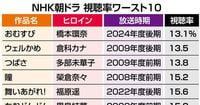The NHK morning drama "Omu Subi," which aired its final episode on March 28, 2025, has officially recorded the lowest average viewership rating in the history of morning dramas, with a disappointing 13.1% in the Kanto region. This data was released by Video Research on March 31, 2025, revealing that the drama, starring actress Kanna Hashimoto, fell below the previous record held by "Welkame," which had an average rating of 13.5% in the second half of 2009.
Throughout its 125 episodes, "Omu Subi" struggled to captivate audiences, with the highest viewership rating being 16.8% for the first episode. The average individual rating during the show's run was recorded at 7.4%. In contrast, the preceding drama, "Torani Tsubasa," achieved a significantly higher average rating of 16.8%, indicating a stark decline in viewership for NHK's morning series.
In addition to the Kanto region's figures, the show also faced challenges in other areas. The average ratings were reported at 12.0% in the Kansai region, 13.8% in the Nagoya region, and 12.9% in the Northern Kyushu region. These figures highlight a broader trend of declining viewership across different demographics.
NHK's Media General Manager, Kazuo Yamana, addressed the issue of low viewership during a press conference on March 19, 2025. He suggested that the diversification of viewing methods, including the rise of streaming services, has contributed to the decline in traditional TV ratings. Yamana stated, "I think this is a reflection of that change in how people consume media."
The storyline of "Omu Subi" centers on Yui Yoneda, a heroine born in the first year of Heisei, played by Kanna Hashimoto. The narrative follows her journey as she aspires to become a nutritionist, weaving through her experiences with friends from the "gal" culture of the early 2000s. The drama also tackled significant historical events, including the Great Hanshin-Awaji Earthquake and the Great East Japan Earthquake, as well as the impact of the COVID-19 pandemic.
Despite the ambitious themes, the show failed to resonate with viewers, becoming a topic of discussion regarding the changing landscape of television consumption. Yamana remarked on the show's intent, saying, "We aimed to convey various messages through the story of a girl with a 'gal spirit' who works hard and connects with others. I believe depicting events like the Great Hanshin-Awaji Earthquake and the Great East Japan Earthquake was a kind of challenge for us."
As "Omu Subi" concludes its run, it joins a list of other dramas that have recorded low viewership ratings in recent years. Following it are shows like "Welkame" (13.5%), "Tsubasa" (13.8%), and "Hitomi" (15.2%). The trend raises questions about the future of morning dramas on NHK and whether they can adapt to the evolving preferences of their audience.
Looking at the historical context, the average ratings for NHK's morning dramas have fluctuated significantly over the years. For instance, dramas such as "Hanako and Anne" and "Asa ga Kita" achieved ratings above 20%, showcasing the potential for success within this genre. However, the recent decline illustrates a shift in viewer engagement.
In a broader sense, the struggles of "Omu Subi" reflect a common challenge faced by traditional broadcasters in the age of digital media. As audiences increasingly turn to on-demand content, the competition for viewership becomes fiercer, making it essential for networks to innovate and adapt their programming strategies.
As the dust settles on "Omu Subi," viewers and industry experts alike will be watching closely to see how NHK responds to this latest setback. Will they pivot towards more engaging storytelling, or will they continue to explore themes that resonate with a changing audience? Only time will tell, but one thing is clear: the landscape of morning dramas is evolving, and NHK must navigate these changes to regain its footing in the hearts of viewers.






